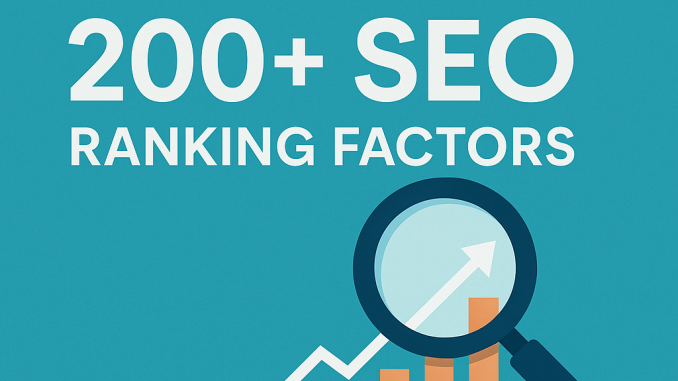
Search engine optimization involves hundreds of factors across several key categories. Here’s a reorganized guide, succinct yet comprehensive:
On‑Page SEO
These factors focus on the content and structure of individual pages:
Keyword research & placement: Target the right terms and place them strategically in titles, headings, URLs, and meta tags.
Title tags & meta descriptions: Craft concise, relevant, and keyword-rich titles; meta descriptions boost both relevance and click-through rates.
Header tags (H1–H3): Use them to structure content clearly.
Content quality & length: Prioritize originality, comprehensiveness, and readability; longer, valuable content (1,000+ words) often performs better.
Keyword density, proximity & prominence: Use naturally varied keywords and LSI terms near each other, especially early in the text.
Content freshness & updates: Regularly refresh updated content to stay relevant.
Image and multimedia optimization: Use descriptive filenames, alt tags, and optimize media for performance.
Internal & outbound linking: Interlink related content and cite authoritative external sources.
URL structure & readability: Keep URLs clean, logical, and keyword-informed.
Readability: Write in a clear style to engage users.
Technical SEO
These factors deal with site architecture and performance:
Site speed & Core Web Vitals (LCP, FID, CLS): Optimize loading, responsiveness, and stability for better UX ().
Mobile-friendliness & mobile-first indexing: Design responsively and prioritize mobile content.
HTTPS/SSL: Secure connections are essential and linked to rankings ().
XML sitemaps & robots.txt: Ensure comprehensive indexation and proper crawl directives.
Breadcrumbs & structured data (schema): Improve navigability and enable rich SERP features.
Canonical tags, duplicate content, redirect handling: Avoid duplicate content and optimize link equity.
Image compression, lazy loading, CSS/JS minification: Improve performance.
Server uptime, location, CDN usage: Enhance reliability and speed.
JavaScript compatibility: Ensure critical content remains crawlable.
Off‑Page SEO
These factors reflect your website’s reputation and authority:
Backlink quality & diversity: Earn links from credible, relevant domains; quantity helps, but quality matters most.
Anchor text variety: Use natural, contextually relevant text—and avoid spammy repetition.
Brand mentions & social signals: Mentions, shares, and social engagement add value—even if nofollow().
Guest posts, press releases, and directory listings: Encourage diverse linking and brand visibility.
Influencer outreach & forums: Build authority through mention and engagement.
User Experience (UX) & Behavioral Signals
These insights derive from how users interact with your site:
Click-through rate (CTR), bounce rate, dwell time: Better engagement sends positive signals ().
Session duration, scroll depth, repeat visits, bookmarks: Indicate deeper interest and quality.
Pageviews per session, conversions, on‑page interactions: Show user satisfaction and engagement.
Mobile UX elements: Tactile usability and responsive design matter.
Content & Topical Signals
Focus on relevance and depth:
Topical authority & semantic coverage: Use comprehensive, entity-rich content to establish expertise.
User intent alignment: Tailor content to informational, commercial, transactional, or navigational queries.
Multilingual and localization elements: Cater to global and local audiences.
Formats like lists, guides, and PDFs: Help improve structure and engagement.
Accuracy, grammar, author credibility: Especially for YMYL content, E‑E‑A‑T is vital ().
Domain & Brand-Level Signals
These factors involve broader site attributes:
Domain age, registration duration, history: Provide signals of stability—though age alone is minor().
Exact match domains, WHOIS privacy & TLDs: May have niche impacts, especially regionally.
Brand strength & recognition: Brand searches, media presence, and trust all influence rankings.
Local SEO
Specific to location-based optimization:
Google Business Profile & local citations: Keep NAP data consistent.
Reviews & star ratings: Key factors in local pack rankings ().
Local keyword targeting & proximity: Incorporate location terms; proximity boosts visibility.
Local schema markup & geo elements: Signal relevance to search engines ().
Algorithm-Driven & Miscellaneous Signals
These refine performance based on algorithms:
Google algorithm updates (Penguin, Panda, Fred, Medic, Possum): Awareness and adaptation help maintain ranking health.
Spam signals & oversaturation: Avoid over-optimization—too many ads, pop-ups, or affiliate clutter can trigger penalties.
User personalization & location signals: Search results may vary by user history or locale().
SERP feature optimization: Structured data for featured snippets, FAQs, knowledge panels, etc.
Pop-up management, CTA clarity, internal search usability: Improve experience and reduce friction.
Document-level trust signals: Author info, terms/privacy pages, and transparent policies matter for E‑E‑A‑T.
✅ Final Takeaways
Focus on the Big Wins: Quality content, strong backlinks, reliable technical performance, and user experience.
Layer in Details: Add schema markup, local SEO elements, structured content formats, and behavioral optimization.
Monitor & Adapt: Stay current with algorithm updates and adjust your strategy accordingly.
Maintain Credibility: Avoid spam, deceptive practices, or intrusive design that might trigger penalties.

Leave a Reply